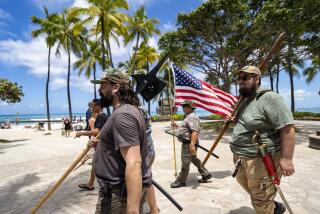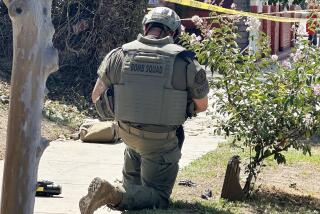Gangs, Crime and Dreams Live Where Deputy Died
The name conjures up images of resort living, lush tropics, the beach -- unless you know its thin genesis was a thatched bamboo refreshment shack run by a man some say was a Prohibition-era bootlegger.
“You hear the name ‘Hawaiian Gardens’ and you think of someplace nice and then when you get here you’re like: ‘Oh, OK,’ ” said Unaloto Makanesi, 18, whose family moved to the tiny city two years ago, drawn here because they could afford to buy a house.
Makanesi, like others in the community where a sheriff’s deputy was fatally shot Friday, is well aware of what many outsiders think of her hometown.
The closest thing it has to an ocean view is the concrete flood control channel called Coyote Creek. The strip malls look tired and many stores are vacant. Storeowners cite numerous robberies. On Makanesi’s block, some houses are neatly kept, others have peeling paint and rusted swing sets on the front lawns.
The main -- perhaps only -- tourist attraction in the town of about 15,000 is a massive 8-year-old casino complex sold to citizens as the way to realize the paradise promised by the name.
The killing of Jerry Ortiz, 35, a 15-year veteran of the L.A. County Sheriff’s Department working on gang suppression, underscored the city’s reputation for crime and danger. After a massive door-to-door search, Jose Luis Orozco, a 27-year-old reputed gang member with devil horns tattooed on his head, was arrested in a Hawaiian Gardens home the next day.
Hawaiian Gardens is one of the smallest cities in California -- measuring less than one square mile -- but it is beset by big problems. The massive loss of manufacturing jobs by the early 1990s in southeast Los Angeles County cut deep in the working-class, predominantly Latino community.
Sheriff’s officials said street gangs are a major force in the city. Census figures indicate that a third of adults over 25 did not finish ninth grade and that 22% more did not receive high school diplomas. Nearly 40% of households reported an annual income of less than $25,000.
The shooting has residents rising to defend their city.
“It’s not as bad as everyone thinks it is,” said Makanesi, echoing the sentiment of elected officials and loyal residents, some of whose families have lived there for generations.
In recent years, the city has been best known for its casino and the man behind the operation. Irving I. Moskowitz, a retired obstetrician who now lives in Miami Beach, has dominated city affairs from afar with a casino that provides about three-quarters of the city budget.
Moskowitz has attracted international scrutiny because of how and where he uses the millions of dollars in revenue the casino generates. A longtime backer of right-wing Jewish groups in Israel, he generously funds causes that include buying land in Arab neighborhoods of Jerusalem and turning it over for Jewish settlement.
But Hawaiian Gardens has long been beset by trouble closer to home.
A few blocks from Makanesi’s house, Robert Anaya, 25, was at work Monday at his family’s shop. His parents opened Durango Produce Market a few years after his birth. The rhythm of the neighborhood and the customers is familiar. Twenty years earlier, his family moved from Hawaiian Gardens to Cerritos after their home was burglarized, but they maintained the store and their ties to the neighborhood.
Lately, Anaya said, his unease has grown. In the last five years, he said, the shop has been robbed two or three times. Sometimes, customers leaving after cashing a check are chased for their money by people wielding screwdrivers. Across the street, he can see a shuttered store, one of many vacant retail buildings nearby.
“I think its getting worse. It’s getting pretty dangerous. That’s why I don’t stand outside anymore, honestly,” he said.
Only a few areas patrolled by the Sheriff’s Department have more serious and violent crime per capita than Hawaiian Gardens. After rising sharply in 2004, serious crime appears to be down slightly so far this year, department statistics indicate.
But Capt. David Fender, commanding officer of the Lakewood sheriff’s station responsible for patrolling Hawaiian Gardens, said the city’s gang members are entrenched. Despite anti-gang efforts funded by casino revenues, Fender said, change has been hard to tackle.
“We have kids -- youngsters -- there whose parents were gang members we arrested,” he said. “We have any number of problems, and these gang members’ parents aren’t holding their kids accountable.”
Fender said Hawaiian Gardens’ multigenerational gangs can make patrolling the streets perilous for deputies. Ortiz was working alone when he was killed.
Outside the apartment complex where he was shot, residents and friends created a makeshift memorial of balloons, candles, a Virgin Mary statue and bouquets of red roses and white and pink carnations.
Lorraine Garcia, 46, lives in a two-bedroom apartment above the residence where the shooting occurred. For 12 years she has worked as a crossing guard for Hawaiian Elementary School. The mother of four grew up here. She knows all her neighbors and most of the deputies who cruise the streets.
“I like it. I’ve lived here all my life, and I would have moved out a long time ago if I didn’t,” she said.
Mayor Leonard Chaidez said Ortiz’s killing came at a time he otherwise described as an upswing for the community, where he has lived since 1971. Since 1999, Chaidez said, the city has increased its public safety budget by 56%.
“The crime is not as bad as it appears to be,” said Chaidez, who attributed the crime rate largely to a small number of people. “We’ve done a lot of good things.”
The mayor ticked off a list of improvements planned or in progress, including an increase in the housing rehabilitation budget, a free lunch program for senior citizens and street improvement projects aimed at creating better access for emergency vehicles.
For historian D.J. Waldie, who has studied L.A. suburbs, Hawaiian Gardens is an anomaly: a city with a significant number of low-income residents nestled next to more prosperous areas, including Cerritos and East Long Beach. Despite its struggles to replace well-paying blue-collar jobs that disappeared over the last generation, Waldie said, Hawaiian Gardens was “obviously a community that has lots of strengths.”
“The name reflects the aspirations of working-class homeowners of an earlier era,” Waldie said, “their desire for a comfortable life and a home in a community that was modern and forward-thinking.”
Some lifelong residents, however, now say they believe they have to look elsewhere for that ideal. For Henry Centeno, 24, guidance has come from a local organization, Way Out Ministries, that has kept him focused on making a better life.
Centeno plans to save money from his banking job in Wilmington and move to another town, where the streets aren’t cluttered with trash and cars aren’t parked on lawns.
“There’s two types of roads you can take when you live here,” he said. “There’s the gangsta road and the ‘trying to get out of the ghetto road.’ A lot of good people live here, but there’s those bad influences that make a big influence on the city.”
*
Times staff writer Richard Winton contributed to this report.
*
(BEGIN TEXT OF INFOBOX)
Sizing up a city
Here’s a look at Hawaiian Gardens, one of the smallest cities in California, based on the 2000 Census:
*--* Population 14,915 Hispanic 10,978 White 1,621 Asian 1,233 Black 689 Other 394 Average household income $43,707 Median age 25.4 Median owner-occupied housing value $121,250 *--*
*--* Size (in square miles): Hawaiian Gardens 0.98 Cudahy 1.12 Maywood 1.18 Artesia 1.62 Hidden Hills 1.65 West Hollywood 1.88 Lomita 1.90 Bradbury 1.91 Lawndale 1.98 Signal Hill 2.23 *--*
More to Read
Sign up for Essential California
The most important California stories and recommendations in your inbox every morning.
You may occasionally receive promotional content from the Los Angeles Times.











